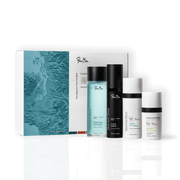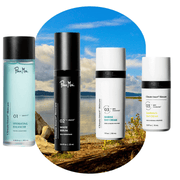14 October 2024
Just because rain is water doesn’t mean it hydrates your skin. Rainy regions can actually dehydrate, cause dryness, and damage your skin due to chemicals and pollutants present in rainwater. Which beckons the question: Is rain good for your skin?
Despite all the cozy vibes rainy days bring – pumpkin spice, warm blankets, a flickering fire – is rain good for your skin? 🤔
Just because rain is water doesn’t mean it hydrates your skin. Rainy regions can actually dehydrate, cause dryness, and damage your skin due to chemicals and pollutants present in rainwater. Which beckons the question: Is rain good for your skin?
We’ll break down the unique effects of rain on your skin, why it’s different from regular water, and how to find the best rain and wind protection for your face with Pour Moi’s Climate-Smart® Rotating Systems.
Grab a blanket, cozy beverage, and learn how to reach for more than an umbrella to protect your skin from rain. ☔
Is Rain Good for Your Skin? Here’s What the Science Says
When we think of rainwater, we might assume it’s clean, pure, and hydrating. No lead leaking from old pipes or heavy metals and pollutants from industrial waste, right? Just the liberating, natural glamor of Rachel McAdams in The Notebook or Hilary Duff in A Cinderella Story. 💅
But rainwater isn’t as “clean” or “hydrating” as you might think, and contains some metals you might not expect.
Research from the University of Stockholm found that pretty much all rainwater across the globe has high levels of per- and poly-fluoroalkyl substances (PFAS), which are forever chemicals that can cause cancer, immune system issues, and pregnancy complications. [1]
Is rain good for your skin or bad, then? Don’t worry; you won’t experience health issues like that from simply getting caught in the rain. But your skin still takes a hit from water’s chemical components. 😩
Let’s look at some of the chemical components of rainwater that can affect your skin.
How Rainwater Damages Your Skin
Water, in its purest form (H2O), is the result of hydrogen and oxygen. But water is rarely pure. In fact, most water has hundreds of dissolved substances and ions that must be distilled or deionized to become pure. [2]
Where do all these dissolved substances come from? The air, which might be more or less polluted, depending on where you are. Do you live in Seattle or Honolulu? Heavy metals, sediments, fossil fuels, volcanic dust, sulfur, and carbons can easily infuse themselves into rainwater.
Now that once-hydrating H2O could turn into a total skin dehydrator. Pair that with the fogginess, wildfires, and humidity, and your skin battles:
- Vitamin D deficiency from overcast days
- Dryness and damage from wildfires
- Enlarged pores and oily skin from humidity
- Disrupted pH balance from rain’s pollutants
Potential Hydrogen (pH), measures a substance’s balance from 1 (acidic) to 14 (alkaline). The sweet spot is somewhere in the middle, though rain’s pollutants can tip your skin’s balance toward acidic.
The bad news? You can’t control Seattle’s rainy season. The good news? You can develop a Seattle skincare routine to protect your visage. ✨And the same goes for any rainy or tropical climate!
How to Handle Your Skin During the Rainy Season: 3 Steps
The rainy season can put your skin through the ringer with dryness and vitamin deficiencies. Here are a few easy steps to combat it:
Monitor your skin for irritation and conditions
Rainwater can expose your skin to pollutants that cause more serious skin conditions like eczema or contact dermatitis.
Regularly assess your skin and look for signs of these common issues, like flaky skin, rashes, blisters, or redness. If you notice any of these symptoms worsen, consult your physician to make sure you aren’t experiencing a more serious skin condition.
Prioritize Vitamin D and SPF
Foggy days mean you don’t have to wear SPF, right? Not so fast. Those pesky UV rays still peep through the thickest clouds. Scientists found that as much as 80% of the sun’s UV rays still penetrate Earth on cloudy days. [3]
Plus, your skin might experience even higher levels of UV during humid, sunny days that beam throughout the rainy season, too.
While overcast days don’t eliminate UV rays, they do limit the amount of vitamin D your skin can absorb from the sun. One study examined the relationship between Vitamin D3 synthesis and cloud coverage and discovered a decrease of the essential nutrient when the clouds were bigger. [4]
Here are some food items to include in your diet for more Vitamin D:
- Cod liver oil
- Rainbow trout
- Salmon
- Mushrooms
- 2% Milk [5]
But studies show that supplements and diet alone won’t penetrate the skin’s surface.
You can lock in Vitamin D with our innovative Sunlight Drops. Using an active chicory root derivative, this Weather-Proof drop will activate your skin’s ability to recover and reconstruct just like Vitamin D, without the harsh UVs.
Pick a skincare routine tailored to your rainy climate
At Pour Moi Skincare, we spent a decade researching to tell you that genetics alone don’t shape your skin conditions. Climate does.
“Sun, dry heat, excess humidity, poor air quality — these are just some of the conditions that stress out our skin’s barrier,” says Pour Moi Skincare’s founder, Ulli Haslacher.
That’s why we developed our Climate-Smart® Rotating Systems.
You can learn more about how we create our climate skincare products in this video from our production facility in France with Strand Cosmetics. Here’s how expert cosmetic chemist Gaëlle André describes Pour Moi’s priorities in our production:
“We worked a lot on the raw materials of the textures for them to be biomimetic [and] to protect the skin because climate, the humidity, and the temperatures… they alter the barrier of the skin.”
So when we pair that process with rainy seasons, we get our revolutionary Pacific Northwest Climate-Smart Rotating System. It includes four skincare products to tackle the changing climate conditions in your area, including a:
- Hydrating Balancer to restore oil in humidity
- White Serum to counteract oxidation from wildfires
- Marine Day Cream to protect your skin barrier
- Temperate Day Cream to absorb moisture and protect from stressors like rain
Uncertain which of our skincare systems is best for your location? Discover the perfect match for your climate here.
Stay Hydrated in the Rainy Season with Pour Moi!
So, is rain good for your skin? The science says no. Residents of areas with rainy seasons don’t just have to protect themselves from rain’s pollutants on the skin — overcast days, periods of humidity, and wildfire smoke can also take their toll on your skin’s barrier.
Pour Moi Skincare is the only company in the world that offers climate-tailored skincare products that deliver 100% satisfaction. After using our products, 100% of our customers in one survey said their skin was more:
- Even-toned and lifted
- Supple and hydrated
- Youthful and brighter
Don’t let the rainy season rain on your skin’s hydration. Find your perfect climate-tailored skincare system today!
References:
- Bergenholtz-Foglander, J. (n.d.). It’s raining PFAS: even in Antarctica and on the Tibetan plateau rainwater is unsafe to drink - Stockholm University. https://www.su.se/english/news/it-s-raining-pfas-even-in-antarctica-and-on-the-tibetan-plateau-rainwater-is-unsafe-to-drink-1.620735
- Weird science: Pure water and water mixtures | manoa.hawaii.edu/ExploringOurFluidEarth. (n.d.). https://manoa.hawaii.edu/exploringourfluidearth/chemical/chemistry-and-seawater/salty-sea/weird-science-pure-water-and-water-mixtures#:~:text=Water%2C%20H2O%2C%20is,water%20has%20to%20be%20created
- Dale Wilson, B., Moon, S., & Armstrong, F. (2012). Comprehensive review of ultraviolet radiation and the current status on sunscreens. The Journal of clinical and aesthetic dermatology, 5(9), 18–23.
- Parisi, A. V., Turnbull, D. J., & Downs, N. J. (2012). Influence of high levels of cloud cover on vitamin D effective and erythemal solar UV irradiances. Photochemical & Photobiological Sciences, 11(12), 1855–1859. https://doi.org/10.1039/c2pp25160d
- Office of Dietary Supplements - Vitamin D. (n.d.). https://ods.od.nih.gov/factsheets/VitaminD-HealthProfessional/#:~:text=of%20Vitamin%20D-,Food,sources%20%5B17%2C1%5D.







